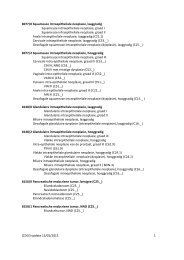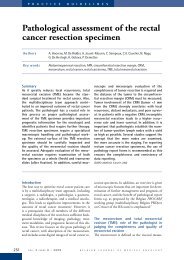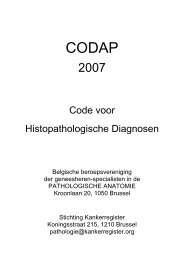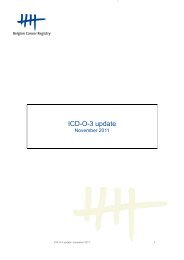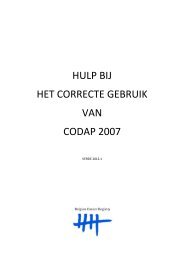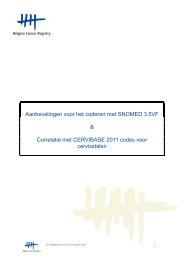Assurance de qualité pour le cancer rectal – phase 2 ...
Assurance de qualité pour le cancer rectal – phase 2 ...
Assurance de qualité pour le cancer rectal – phase 2 ...
Create successful ePaper yourself
Turn your PDF publications into a flip-book with our unique Google optimized e-Paper software.
KCE Reports 81 PROCARE <strong>–</strong> <strong>phase</strong> 2 25Disease-specific 5-year survival by stageDEFINITIONNumerator: all RC patients that survived after 5 years or that died due to a diseaseunrelatedcause, by stage.Denominator: all RC patients.Exclusion criteria:• patients treated abroad• patients without a social security number• patients without a Belgian postal co<strong>de</strong>• patients without a known inci<strong>de</strong>nce date or with an inci<strong>de</strong>nce date afterDecember 31st 2006.RESULTSSince no accurate data are availab<strong>le</strong> on the cause of <strong>de</strong>ath in both databases, diseasespecificsurvival as such is not measurab<strong>le</strong> at present. Above this, follow-up in thePROCARE database ends in case of local or distant recurrence.However, relative survival is a frequently used parameter in <strong>cancer</strong> epi<strong>de</strong>miology andcan be used as a proxy of the disease-specific survival [10]. For the calculation of therelative survival, the numerator is <strong>de</strong>fined as the observed rate of <strong>rectal</strong> <strong>cancer</strong> patientssurviving five years after diagnosis, whi<strong>le</strong> the <strong>de</strong>nominator is <strong>de</strong>fined as the expectedsurvival rate of a comparab<strong>le</strong> group (age, gen<strong>de</strong>r and region) from the generalpopulation.Again, since the PROCARE database is relatively young, a 5-year survival analysis is notyet possib<strong>le</strong>. At present, an accurate survival analysis is only possib<strong>le</strong> at 1 year (Tab<strong>le</strong> 11and Tab<strong>le</strong> 12) Using the coup<strong>le</strong>d administrative database, a full 5-year survival analysis ispossib<strong>le</strong> (Tab<strong>le</strong> 13 and Tab<strong>le</strong> 14).For 1062 of the 1071 PROCARE patients (99%) all necessary data were known. Ofthese 1062 patients, 866 had an inci<strong>de</strong>nce date before January 1 st 2007.The relative 1-year survival is measurab<strong>le</strong> for 55 centres using the PROCARE databaseand ranges from 66 <strong>–</strong> 105% for the (y)pStage I-III patients. Thirty-seven centres have a1-year relative survival (for the (y)pStage I-III patients) above the weighted (96%; 95%CI95 <strong>–</strong> 98%) and unweighted mean (97%; 95%CI 94 <strong>–</strong> 99%).Tab<strong>le</strong> 11. 1-year relative survival rate by cStage using the PROCAREdatabase*, calculated with actuarial (life tab<strong>le</strong>) method.N N <strong>de</strong>aths on 31/12/2006 1-yearAll I 73 0 103%II 124 6 95%III 279 10 97%IV 80 13 76%X 310 21 94%I-III 476 16 97%Total (I-IV) 866 50 94%Ma<strong>le</strong>s I 42 0 103%II 81 4 95%III 175 8 96%IV 43 4 87%X 181 17 92%I-III 298 12 97%Total (I-IV) 522 33 94%Fema<strong>le</strong>s I 31 0 102%II 43 2 94%III 104 2 99%IV 37 9 65%X 129 4 97%I-III 178 4 98%Total (I-IV) 344 17 94%* Mean follow-up: 8 months (range 0-24 months).



